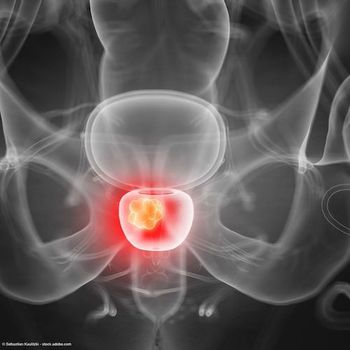
Bladder-sparing trimodal therapy yields similar results as radical cystectomy in MIBC
The 5-year metastasis-free survival rate was 75% with trimodality therapy vs 74% with radical cystectomy.
Findings from a retrospective study published in Lancet Oncology demonstrated that trimodality therapy produced similar oncologic outcomes as radical cystectomy in patients with muscle-invasive bladder cancer (MIBC).1
“These results support that trimodality therapy, in the setting of multidisciplinary shared decision making, should be offered to all suitable candidates with muscle-invasive bladder cancer and not only to patients with significant comorbidities for whom surgery is not an option,” the study authors wrote.
The 5-year metastasis-free survival (MFS) rate was 74% (95% CI, 70%-78%) with radical cystectomy vs 75% (95% CI, 70%-80%) with trimodality therapy based on inverse probability treatment weighing (IPTW); the 5-year MFS rates in each respective treatment group were 74% (95% CI, 70%-77%) and 74% (95% CI, 68%-79%) using propensity score matching (PSM).
Investigators indicated that there was no difference in 5-year MFS between treatment groups based on IPTW (subdistribution hazard ratio [SHR], 0.89; 95% CI, 0.67-1.20; P = .40) and PSM (SHR, 0.93; 95% CI, 0.71-1.24; P = .64).
With radical cystectomy and trimodality therapy, respectively, the 5-year distant failure-free survival rates were 78% (95% CI, 74%-82%) and 77% (95% CI, 72%-82%) using IPTW (SHR, 0.94; 95% CI, 0.68-1.28; P = .58). The 5-year distant failure-free survival rates in each group were 82% (95% CI, 78%-84%) and 78% (95% CI, 71%-82%) by PSM (SHR, 0.95; 95% CI, 0.70-1.28; P = .74).
The 5-year regional failure-free survival rates with radical cystectomy and trimodality therapy, respectively, were 95% (95% CI, 93%-97%) and 91% (95% CI, 89%-93%) based on IPTW (SHR, 1.56; 95% CI, 0.89-2.74; P = .15). The 5-year regional failure-free survival rates by PSM in each respective group were 76% (95% CI, 72%-80%) and 76% (95% CI, 71%-81%; SHR, 0.88; 95% CI, 0.67-1.16; P = .37).
Investigators of the retrospective analysis evaluated data between January 1, 2005, and December 31, 2017 from patients with cT2-T4, N0M0 MIBC who were eligible to undergo both radical cystectomy and trimodality therapy. Patients made the decision to pursue radical cystectomy or trimodality therapy following multidisciplinary discussions of each treatment option.
The predefined primary end point was MFS. Secondary end points included overall survival (OS), cancer-specific survival, distant metastatic failure-free survival, regional failure-free survival, and disease-free survival. Investigators determined differences in survival outcomes based on PSM using logistic regression and 3:1 matching with replacement and IPTW.
Patients with solitary MIBC tumors less than 7 cm in their greatest dimension were included in the analysis. Additional inclusion criteria included having no or only unilateral hydronephrosis, adequate bladder function, and no extensive or multifocal carcinoma in situ.
Investigators used 3:1 matching in a population of 1119 patients, 837 of whom underwent radical cystectomy and 282 underwent trimodality therapy. The median patient age was 71.4 years (interquartile range [IQR], 66.0-77.1) in the cystectomy group and 71.6 years (IQR, 64.0-78.9) in the trimodality group. In the cystectomy and trimodality groups, respectively, most patients were male (75% vs 76%), had cT2 stage disease (90% vs 90%), did not undergo hydronephrosis (88% vs 90%), and received neoadjuvant or adjuvant chemotherapy (59% vs 56%).
In the radical cystectomy and trimodality therapy groups, respectively, the 5-year cancer-specific survival rates were 81% (95% CI, 77%-85%) and 84% (95% CI, 79%-89%) using IPTW (SHR, 0.72; 95% CI, 0.50-1.04; P = .071). In each respective group, the cancer-specific survival rates were 83% (95% CI, 80%-86%) and 85% (95% CI, 80%-89%) using PSM (SHR, 0.73; 95% CI, 0.52-1.02; P = .057).
The 5-year OS rate was 66% (95% CI, 61%-71%) with radical cystectomy vs 73% (95% CI, 68%-78%) with trimodality therapy based on IPTW (SHR, 0.70; 95% CI, 0.53-0.92; P = .010). The 5-year OS rates for each respective group were 72% (95% CI, 69%-75%) vs 77% (95% CI, 72%-81%) using PSM (SHR, 0.75; 95% CI, 0.58-0.97; P = .0078).
Overall, 13% of patients receiving trimodality therapy underwent salvage cystectomy. Of 440 patients who underwent radical cystectomy, the final pathological stage was pT2 in 28% of patients and pT3-4 in 44%, and 26% of patients had node-positive disease. Additionally, the median number of nodes removed was 39 (IQR, 21-57), the soft tissue positive margin rate was 1%, the 90-day perioperative mortality rate was 2.5%, and 3% of patients had local recurrences.
Reference
1. Zlotta AR, Ballas LK, Niemierko A, et al. Radical cystectomy versus trimodality therapy for muscle- invasive bladder cancer: a multi-institutional propensity score matched and weighted analysis. Lancet Oncol. Published online May 12, 2023. doi:10.1016/S1470-2045(23)00170-5
Newsletter
Stay current with the latest urology news and practice-changing insights — sign up now for the essential updates every urologist needs.




















